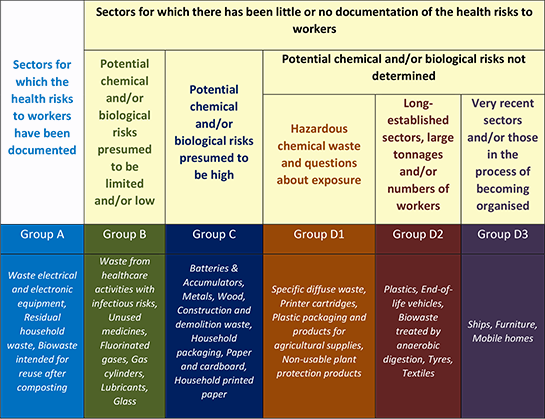
Gaining a better understanding of the health risks to waste management workers
The waste management and recycling industry is central to circular economy policies and is growing all the time. The occupational health of professionals in this industry is a real challenge and was examined by ANSES in an initial expert appraisal, whose results are published today. The Agency provided an overview of the industry, and conducted an analysis to group together different waste management sectors according to their impact on worker health. Although it noted a lack of data on the health risks to waste management workers, the expert appraisal highlighted exposure to multiple risk factors, mainly associated with chemicals, bacteria and mould in waste, noise and mechanical vibrations, and organisational constraints. Risks to mental health associated with the working conditions, organisation and attitudes to occupations in this sector also need to be considered. ANSES is therefore making recommendations with a view to acquiring knowledge on the health risks to workers, raising awareness of risk prevention and improving medical monitoring of waste workers. It is also recommending that the health impacts on these professionals be integrated into eco-design activities. As a first example for the industry, the Agency proposes conducting a risk assessment on the household packaging sector, with its multiple health and socio-economic challenges.
Workers exposed to multiple risks
The waste management industry is booming and constantly evolving. It encompasses the collection, recycling and disposal of waste. Waste recycling, an integral part of the concept of the circular economy, consists in transforming waste into a raw material or energy source. It is a vast and complex industry with boundaries that are difficult to define.
The broad variety of waste and the processes used for its collection, recycling or disposal lead to occupational exposure to a wide range of hazards: toxic chemicals, mould, bacteria, high temperatures, intense noise, mechanical vibrations, sources of fire or explosion, close proximity to mechanical or electrical equipment, the presence of sharp objects, vehicle traffic, etc. Workers may also be exposed to arduous working conditions involving the carrying of heavy loads, repetitive gestures, and night or shift work. Lastly, mental health risks, which are too often neglected, can also be linked, for example, to working alone, violence or incivility, and a lack of recognition.
In France, the waste collection, treatment and disposal industry is one of the occupational sectors reporting the most frequent and most serious accidents at work. In 2016, there was an average of 59 occupational accidents per 1,000 employees for this industry's activities, compared with 33.8 per 1,000 employees for all industries as a whole.
Gaining a better understanding and taking better account of the health risks of workers in this industry
In general, ANSES highlights the lack of precise data on the health risks faced by workers in the waste industry.
It therefore recommends improving knowledge on health risks to workers through specific studies and the creation of a collective-data gathering tool. The Agency also recommends strengthening prevention and raising awareness among stakeholders, and improving medical monitoring to protect the workers involved in waste management. In addition, it recommends that the health challenges of these professionals be taken into account in eco-design approaches.
Categorisation of waste management sectors
ANSES examined 28 waste management sectors that provide an overview of the industry.
In order to identify and distinguish the sectors in terms of their impact on the health of professionals working in them, several criteria were studied: potential risks associated with the toxicity of chemicals, risks associated with the presence of bacteria or mould in waste; the level of documentation of these health risks; the quantities of waste produced, collected and treated within each sector; the number of workers involved in each sector's activities; and consideration of the economic and technical developments in the sectors over the coming years.
On the basis of these criteria, categorisation work was then carried out to group together sectors with common characteristics.
Six sector categories were defined:

Meaning of potential risks:
High: Workers are exposed to hazardous chemical and/or biological agents within the sector.
Limited: Hazardous chemical and/or biological agents have been identified within the sector, but there is evidence to suggest that worker exposure is controlled.
Low: There is no suspicion of worker exposure to hazardous chemical and/or biological agents in the sector.
Not determined: Workers may be exposed to hazardous chemical and/or biological agents within the sector (exposure not documented or hazards not identified in the literature consulted).
For each of these sectors, ANSES has formulated specific recommendations:
- for sectors for which the risks have been documented, ANSES recommends assessing and, if necessary, strengthening preventive measures ;
- for sectors for which the risks could not be estimated, ANSES recommends carrying out research in order to gain a better understanding of the hazards and exposures to which workers are subjected. In particular, it proposes including topics related to the "end-of-life vehicles" and "biowaste recycled by anaerobic digestion" sectors in the research projects of the National Research Programme for Environmental and Occupational Health (PNR-EST) that it funds ;
- lastly, for sectors where potential risks have been defined, ANSES recommends carrying out health risk assessments for workers. In this context, the experts identified three sectors requiring special investigation: construction, wood and household packaging. As a first example, the Agency decided to conduct a risk assessment on the "Household packaging" sector. Indeed, in view of the current context, with a broadening of the sorting instructions and a reduction in waste being exported abroad, this sector is now obliged to absorb a significant volume of waste. One of the challenges of this future expert appraisal will be to refine methods for assessing the risks associated with the presence of bacteria, mould or other micro-organisms in work environments.